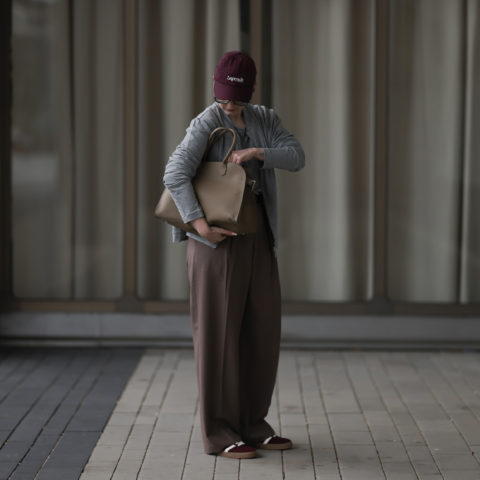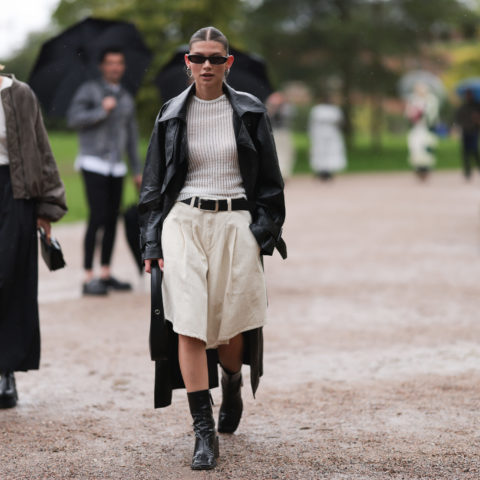These Small-Batch Designers are Saving the Planet by Producing Less
“I feel there is so much in the world. We have too much of everything and it’s a scary concept.”
In 1973, a German statistician named E.F. Schumacher published a book called “Small is Beautiful.” In it he noted that industrial society is careening towards collapse thanks to its extraction of natural resources at an inexhaustible pace. He also proposed we scrap the current economic system in favour of “a lifestyle designed for permanence.”
Schumacher’s ideas were received as radical at the time, but they’ve translated remarkably well into the arena of cuisine, where few would doubt the superiority of a locally-grown organic heirloom tomato over a mealy, waterlogged foreign facsimile left to ripen under supermarket’s fluorescent lights. And yet, many of the same people who are willing to pay $5 for a bottle of small-batch artisanal kombucha still shop fast fashion without reservation. The act of ingesting only the purest ingredients in the name of “wellness” has practically become a secular religion, but when it comes to our closets, most people still tend to turn a blind eye.
Over the past decade, brands like Frank And Oak and Eileen Fisher have become more eco-conscious, mitigating their impacts through measures such as sourcing only organic cotton, offering clothing repairs, or taking responsibility for their garments at the end of their life cycle. But none of these well-intended methods address the fundamental reason why we’re in this mess in the first place: the overproduction of goods. According to Forbes, as a collective society we purchase 400% more clothing today than we did 20 years ago. The only way to dig ourselves out is, simply, to produce less.
“I feel there is so much in the world. We have too much of everything and it’s a scary concept,” says designer Matty Bovan, a Central Saint Martins graduate who chooses to create his explosively colourful, neo-shamanistic garments out of his parent’s house in York, England. “I really believe we shouldn’t as young designers produce hundreds or thousands of garments.” Bovan isn’t purposefully trying to keep his business small; he prefers to think of it as growing at its own pace. Instead of poising himself to become a stratospherically successful designer tasked with designing multiple collections a year—Bovan is strategically building his business to avoid both creative burnout and the excessive pileup of stuff. “Young people are struggling with the weight of the world; I am trying to understand what it means to be creative in 2018, and how to make it something viable,” he says.
Bovan’s seedling business operates—albeit on a smaller scale—similarly to the way Mona Kowalska, the New York-based designer of A Détacher, has for the past 16 years. A Détacher, which literally means “to be detached,” has rejected the accelerating pace of the industry that requires designers to churn out collections on command. The label is sold in the brand’s single store in Manhattan as well as to a tight edit of 35 department stores. “It’s just never going to be mass,” the designer once told New York magazine. Instead of achieving Andy Warhol’s 15 minutes of fame, Kowalska has managed to cultivate something far more sustainable: a loyal clan of devotees who purchase from the brand season after season. “There are a lot of things out there that could go from the rack to the garbage,” the designer told Fashionista in 2015. “People design a lot of landfill. I don’t want to do that.”
Dame Vivienne Westwood issued the edict, “Buy less, choose well and make it last” in 2014, (though Westwood received RankABrand.org’s lowest possible sustainability score because of the brand’s refusal to release any information on their internal policies; multiple e-mails to Vivienne Westwood’s communications department asking for clarification on the label’s sustainability policies went unanswered) it’s a command that applies to designers just as much as it does to consumers. Anna Yang, who designs the Milan-based label ANNAKIKI, decided to shift the focus for her fall 2018 collection onto longevity, craftsmanship and authenticity after experiencing a bout of what she describes as “aesthetic fatigue.” “I came to a point where there was just too much happening,” Yang says. “ So many clothes are produced and this is confusing for the consumer. I wanted to create a collection where outfits would outlast a season.” The result was a flashy show rife with oversize furry muppet coats, pastel suits and sweatshirts that read “over supply” and “consumed by fashion.” Trench coats barrelled down the runway encased in transparent plastic, but what looked like a metaphor for overconsumption was in fact rooted in practicality: each coat can be worn as at least three garments. Additionally, Yang cut down production run of her collection by 28%, a decision she says she will continue to implement in future seasons.
“If however, economic ambitions are good servants, they are bad masters,” wrote the British historian R.H. Tawney in 1926. Conventional wisdom suggests that the only way a business can succeed is if it is constantly growing. However, exponential growth is impossible on a planet with finite resources like Earth. Eventually the bubble—like Violet Beauregard, who swells into a giant blueberry in Willy Wonka and the Chocolate Factory—must burst.
The best alternative we have is a theory proposed in 2017 by economist Kate Raworth called “doughnut economics,” which proposes to address humanity’s challenging future by embedding the economy in the ecosystem to create natural boundaries that the growth of society must adhere to. It sounds a lot like what E.F. Schumacher initially proposed all the way back in 1973: economics as if people—and the environment—mattered.








